| Article ID | Journal | Published Year | Pages | File Type |
|---|---|---|---|---|
| 1751100 | Renewable and Sustainable Energy Reviews | 2012 | 9 Pages |
Energy recovery from sewage sludge offers an opportunity for sustainable management of sewage sludge and energy. Anaerobic digestion and pyrolysis are among the most promising processes applicable for sewage sludge-to-energy conversion. Anaerobic digestion of sewage sludge forms methane-rich biogas, which can be utilized as fuel to offset heat and electricity consumption of the wastewater treatment sector. However, the digestion process has the limitation that it cannot sufficiently extract the energy in sewage sludge. The digested sludge is still energy profitable in that it contains considerable organic matter, but poor in biodegradability. Sludge pyrolysis is an innovative process that can convert both raw and digested sludge into useful bioenergy in the form of oil and gas, forming biochar as a byproduct that is environmentally resistant and holds potential for carbon sequestration and soil conditioning. It is expectable that sludge pyrolysis would step into practical deployment in the near future.This paper presents a brief overview of anaerobic digestion and pyrolysis in the application to bioenergy production from sewage sludge. An assessment of energy conversion efficiency of two parallel sludge-to-energy pathways is also presented. One pathway relies on an exclusive pyrolysis process (fed with raw sludge) while the other is based on anaerobic digestion followed by pyrolysis (fed with the digested sludge). The pathway via the combination of anaerobic digestion and pyrolysis could achieve higher energy efficiency compared to the pathway employing the pyrolysis alone.
